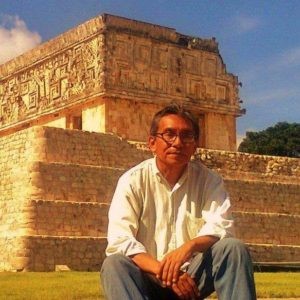Chikindzonot, is a community located in the east of Yucatan, 72 kilometers from the city of Valladolid. Its church, built in the second half of the 18th century -a stone dated in 1793, currently lost, found by an inhabitant of that locality, on one side of the church allows proposing that temporality-, is an important sample of the colonial artistic style, called Christian Mayan.
This style consists of the aesthetic combination, represented in the sculpture, painting or religious architecture, convents, churches, of the Christian ideas taught by the friars to the Mayans, from the second half of the sixteenth century, along with some elements of the indigenous magical-religious thought.
The front of this temple oriented to the west has the main door framed by two stone pilasters joined at the top by a stone molding also. You can also see in this facade, some vertical rows of rhombuses. It also has a coral window, decorated with plant motifs, and at the top, a carved stone relief of the Virgin of Candelaria.
Each pilaster is divided into four parts, with reliefs representing different motifs in each. Starting from the bottom, the first part of both pilasters shows the fierce face of a fantastic being, which would remind us of a faun, surrounded by plant motifs.
Above is the second part, which contains three figures. The first one, from the bottom up, shows a monster with a crocodile head, a fish body with scales, and a snake or fishtail, with the body, arched, biting a bunch of round fruits that are on it, and that constitute the second figure. This cluster of small round fruits comes from an ear of corn, which is the third figure.
Then, the third part shows on the right side of the door, a half-naked man with his hands crossed in front, standing on a round vegetal motif. The left side of the door, in this same third part of the style, has a carved figure of a woman, also half-naked, with her hands crossed in front of her, and above her, a snake biting an apple.

Photo: Indalecio Cardeña
The last part of both pilasters has a sun above the man and a moon above the woman. The pilasters are joined by a molding as said, and finished off, each one of them by a sculpture of St. Peter on the right side, and St. Paul on the left.
The main door and the two side doors are framed with carvings of eight-petal flowers. In this church, in addition to the façade, there are other reliefs and figures that refer both to the persistence of a pre-Hispanic past and to a syncretism, a combination, cultural and religious.
Thus, the base of the triumphal arch of this temple, presents to the front on both sides, an angel standing with his arms up, in action to hold something over it.
The inner side of the bases of this triumphal arch shows the carving of a crowned imperial lion.
On the right side of the entrance to the church is a baptismal font with carved reliefs of animal, plant, and Christian motifs. The faces of four cherubs are symmetrically represented around the font. Each of the faces is framed by five water lily flowers, which open at the end of their long stems. Between each cherub is a crowned imperial lion, so that there are four crowned imperial lions. At the base of the font is carved a cherub with a headdress as a headdress.
The cover of this church shows us a Christian Mayan allegory of the creation. The Popol Vuh and the Genesis are represented there, through two pre-Columbian figures linked to the origin and creation of the universe and human beings: the reptilian monster and the corn, belonging to the Mayan cosmogony, together with the first human beings narrated in the Bible: Adam and Eve.
The facade also presents the geometric forms of the feathered serpent, Kukulcan, through the rhombuses, figures used in the pre-Hispanic era to represent this deity.
For The Yucatan Times
Indalecio Cardeña Vázquez
Merida, Yucatan
February 28, 2020
 Indalecio Cardeña Vázquez. – Anthropologist, researcher and writer.
Indalecio Cardeña Vázquez. – Anthropologist, researcher and writer.
He has collaborated with the “Unidad Yucatán de la Dirección de Culturas Populares”, Instituto Nacional Indigenista and was the director of the Pinacoteca “Juan Gamboa Guzmán” of the INAH
Among his anthropological works are the iconographic analysis of the colonial sacred art of the Yucatan Peninsula; the symbolisms in the facade of Conquistador Montejo’s house, in Mérida; the Mayan symbolism in the Yucatan Cathedral and the archaeoastronomy among the Mayans.
Professor Cardeña has written several books and articles since the mid 1980’s to this date.


